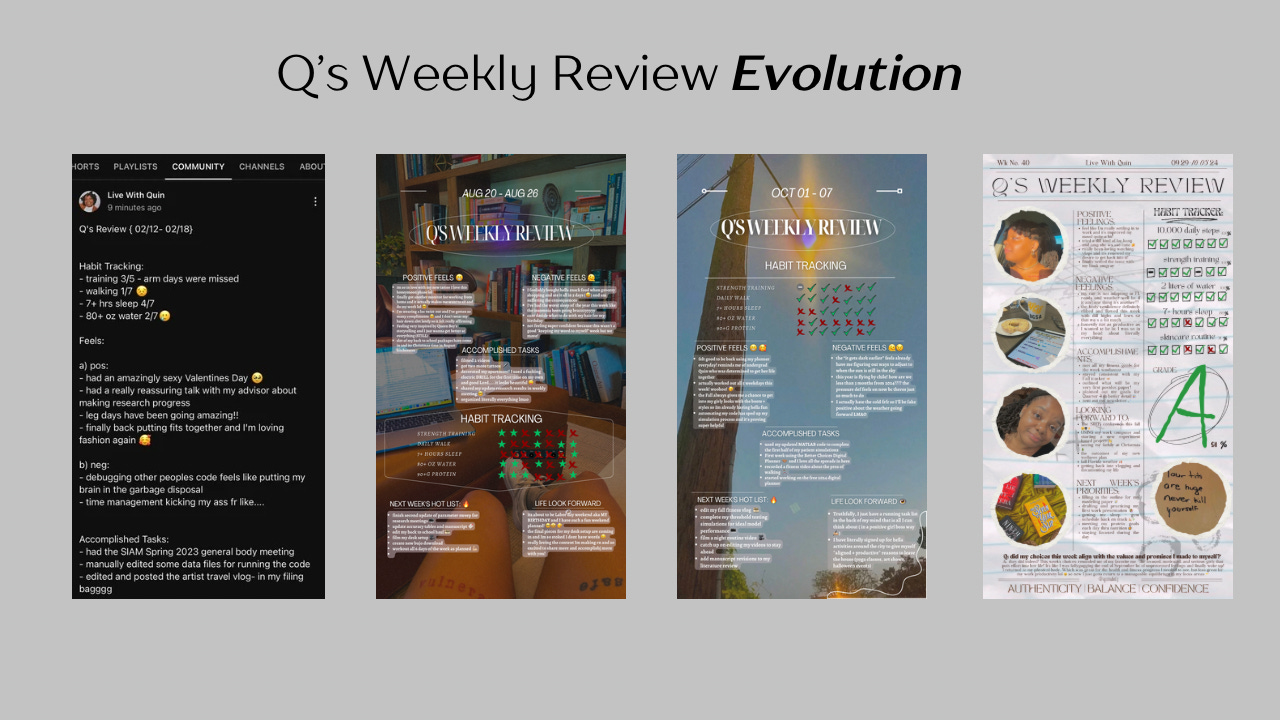We’re officially halfway through the year — a checkpoint that can feel like both a reality check and a fresh start. Whether you’ve been steadily working toward your goals or life has taken you on an unexpected detour, now is the perfect time to pause, zoom out, and ask: What is actually working for me? What needs to change?
It’s easy to feel overwhelmed by how far you still want to go, but I’ve learned that long-term transformation doesn’t come from obsessing over outcomes — it comes from mastering systems. Instead of fixating on whether I’ve “achieved” a goal, I now ask myself: What habits and strategies actually drive the results I want? How can I build a system that supports those every day?
To embody the better me — not just in theory, but in practice — I rely on three core capabilities:
Actively acknowledging where I am and what I’m doing (not just what I’m thinking about doing) → [habit tracking + honesty]
Making a clear plan to get from here to where I want to go → [goal setting]
Implementing strategy and intentionally practicing better choices until they become automatic → [productive accountability]
Over the years, I’ve developed a personal operating system built around this mindset — and it's changed everything: my health, career, confidence, and overall sense of control.
Now, during this midyear reset, I’m using that same system to reflect, recalibrate, and reset — not just my goals, but the framework that supports them.
A true systematic framework for personal growth consists of five parts much like any system:
goals
input
feedback
output
process
Each of these components plays an essential role in not just setting goals, but in the ongoing process of making our desired outcomes inevitable. By viewing personal growth as a dynamic system, we can intentionally design a lifestyle that works for us — one choice at a time.
Applying this objective framework to daily decision making improves the amount of control, consistency, and connectedness we feel to our lives and goals. Having a clear understanding of what our actions contribute to our outcomes increases awareness and thereby intention and control. Collecting and analyzing feedback about our behavior reveals personal patterns that could improve choice consistency. Being so involved in your life’s outcomes through both intention (goal setting) and reflection (habit tracking) helps keep goals front of mind and important.
This is the framework that’s transformed my life and body over the last 5 years and what I’ll be using to continually create the life and career I desire.
So let’s walk through the five essential elements of a true lifestyle system — and how I’m using them to redesign my life in real time through this mid year reset.
✨✨✨✨✨✨✨✨✨✨✨✨✨✨✨✨✨✨✨✨✨✨✨✨✨✨✨✨✨✨✨✨
1 goals
Goals serve as the starting point for any effective system — they give direction, purpose, and a sense of meaning to our efforts. But they don’t just live on a piece of paper; they’re the reason behind every action and decision we make. They set the tone for everything else that follows in your system.
For me, having clear goals helps me focus on what matters most and keeps me aligned with my long-term vision. In this section, I’ll share my personal goals for the year, how I’ve refined them along the way, and what I’m focusing on as we move into the next quarter. These goals are the starting point of my system, and they set the tone for everything else that follows.
2025 goals
Here are my main goals for the year that align with my long-term vision, as well as the specific targets I’m focusing on this quarter. It’s essential to note that I started with a longer list, but through reflection and focus, I’ve narrowed it down to what truly matters.
The most relevant goals for this year that align with my big picture goals are:
Submit Math Modeling Methodology Paper
Submit a Research Grant
Attend SMB 2025 Conference
Get 50 people in WPP
Launch Paid Memberships
Lose 20 lbs and/or 8 inches off waist
Full first draft Aspergillosis ODE Model paper
Pay off my Credit Card
Post 52 videos on YouTube (1x a week)
Grow SubStack to 500 subs
2025 mission statement:
By the end of 2025, I will have earned two first-author publications as a postdoc, grown my online presence as a productive lifestyle vlogger with consistent monthly revenue, and secured a renewed contract while maintaining my health and wellness.
Quarterly Goals
To accomplish these goals by the end of the year, I broke them down into quarterly goals. Quarter Two’s goals include:
submit math modeling methodology paper (80%) → goal moved to Q3
first draft / outline of ODE paper complete (15%) → goal moved to Q3
Monthly 10k step challenge ☑️
buy my passport ☑️
limit the scope of my literature review ☑️
Draft specific aims page of grant idea (5%)
Post 13 YouTube videos 11/13 ☑️
Post 5 paid substack posts 🚫
Finish reading The Testing book trilogy → goal moved to Q3
June Goals
To accomplish these goals by the Quarter 2, I broke them down into monthly goals for April, May, and June. My most recent goals for June were:
submit final draft of methodology paper → goal moved to Q3
Write a research statement + update CV ☑️
June 10k step challenge ☑️
100% adherence to strength training 🚫
Finish The Testing book 1 🚫
Post 5 YouTube videos → 3 posted
Post 3 Weekly Science Diaries on Substack 🚫
Now that we've outlined the goals that shape the direction of our lives, let’s dive deeper into the inputs — the building blocks that fuel our system.
✨✨✨✨✨✨✨✨✨✨✨✨✨✨✨✨✨✨✨✨✨✨✨✨✨✨✨✨✨✨✨✨
2 input:
Inputs are the things that go into the system. These are the things that are needed to use, create, or maintain the system. In lifestyle systems, that looks like our beliefs, resources, habits, and routines. These maintain the life we live.
Now that we’ve established our goals, let’s look at the key inputs — the resources, habits, and beliefs that fuel our system. These are the elements that support the daily grind and keep the system running. Without the right inputs, our system won’t perform at its best.
Each of these daily habits feeds into the larger goal of living a balanced, healthy, and productive life. Every action I take — no matter how small — contributes to the bigger picture, so I prioritize what has the most impact on my health, productivity, and long-term vision.
daily habits:
10,000 steps: 7 days a week -> goal: health / body recomposition
Why this matters: Regular movement ensures I stay active and burn calories, contributing to my fitness and overall well-being.
Strength training: 5 days a week -> goal: health + fitness
Why this matters: Strength training is essential for building lean muscle, boosting metabolism, and increasing overall strength. It not only helps improve body composition (muscle vs. fat) but also supports bone health and mental resilience.
100g+ protein: 7 days a week -> goal: health / body recomposition
Why this matters: Protein is crucial for muscle repair and growth. Consuming adequate protein supports recovery from workouts, helps maintain muscle mass during weight loss, and boosts satiety, making it easier to stick to a calorie-controlled diet.
7 hours sleep: 7 days a week -> goal: health / productivity
Why this matters: Sleep is the foundation of physical and mental health. It’s during sleep that our bodies repair and regenerate, and adequate rest improves mood, cognitive function, and physical recovery, ensuring we're productive and at our best throughout the day.
80 -100 oz water: 7 days -> goal: health + wellness
Why this matters: Staying hydrated is critical for optimal bodily function. Proper hydration supports digestion, nutrient absorption, skin health, and energy levels, while also helping control hunger and improve overall well-being.
Reading: 7 days -> goal: return to hobby
Why this matters: Reading is a powerful mental exercise. It reduces stress, stimulates the mind, and enhances creativity. Re-engaging with reading as a hobby allows me to unwind, learn, and feed my intellectual curiosity outside of work.
Lymphatic drainage: 7 days -> goal: health + wellness
Why this matters: Lymphatic drainage supports detoxification and reduces swelling, improving circulation and immunity. Regular lymphatic massage helps with stress relief, easing tension in the body and promoting relaxation and recovery.
The Daily Column: 7 days -> goal: reflection
Why this matters: The Daily Column is my opportunity to reflect, assess my progress, and track my habits. It keeps me accountable and helps me internalize lessons learned throughout the day. Regular reflection allows me to identify what’s working, what isn’t, and where I can improve, which enhances my long-term growth.
weekly routines:
Weekly routines are the bridges between daily habits and larger goals. They ensure I’m staying on track and refocusing when life gets busy.
Q’s weekly review → shared with WPP
Why this matters: Q’s Weekly Review keeps me accountable to my personal and community goals, ensuring consistent progress and alignment with my larger objectives.
weekly reset routine → for work/life balance
Why this matters: It helps me assess my work-life balance, reset my priorities, and ensure I'm maintaining both productivity and well-being.
recording one video a week → for Live With Dr Quin YouTube
Why this matters: Recording weekly videos keeps my content consistent, builds my brand, and strengthens my public speaking and storytelling skills.
editing one video every weekend → for Live With Dr Quin YouTube
Why this matters: Editing weekly ensures my content is polished and ready for publication, helping me stay on schedule and deliver value to my audience.
weekly project management routine → for Scientific Career Goals
Why this matters: This routine ensures I stay organized and on track with my PhD work, helping me meet deadlines and maintain high standards.
monthly review + reset → for work/life balance + shared with WPP
Why this matters: The Monthly Review helps me reassess my progress, adjust my goals, and recalibrate routines to stay aligned with my long-term vision.
Inputs set the stage, but feedback ensures we're on the right track. By regularly assessing how our actions align with our intentions, we can fine-tune our approach and make necessary adjustments.
✨✨✨✨✨✨✨✨✨✨✨✨✨✨✨✨✨✨✨✨✨✨✨✨✨✨✨✨✨✨✨✨
3 feedback
Feedback is what helps us course-correct and ensure we’re staying aligned with our intentions. Anything that monitors or controls the system, like habit tracking, is considered as feedback.
It's essential to look at the data we've gathered — not just once, but regularly — so we can make adjustments where needed. Without feedback, we can miss opportunities for growth and improvement.
I check in with my system processes through documentation: daily -> weekly -> monthly. These feedback loops allow me to reflect regularly on my progress. By reviewing my behavior consistently, I can make adjustments when needed and understand how small changes in one area of my life may ripple out and affect the others.
To ensure I’m on track, I use a variety of tools to measure progress and reflect on my behavior. These tools allow me to track habits, assess productivity, and evaluate how I’m doing overall. Below are some of the key systems I use for feedback.
Daily:
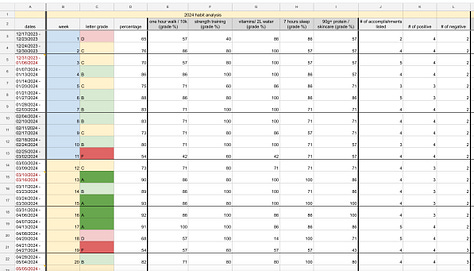

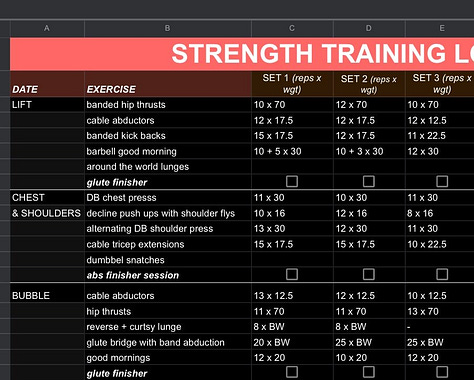
Deficit tracker = health
Every night I complete a row of my daily deficit tracker to make sure I’m in line with my health / weight-loss goals. I track my weight, sleep, calories eaten, protein, carbs, water, steps, and calories burned. I calculate weekly and monthly statistics from this data.
Strength training log = fitness
I workout 5x a week at best and have been logging my progressive overload journey. Each day has my set workout routine and I log each sets reps and weights. This makes sure I’m lifting more (heavier or with more volume) or at maintenance each week.
ToDoIst + Notion = productivity
I schedule my everyday tasks in ToDoIst and Notion. They are categorized in each software by both area (PhD, YouTube, Health) and priority (1,2,3).
The ToDoIst app is a to do list app where I have recurring weekly tasks set and update daily to organize my priorities.
Notion is a my digital bullet journal and is how I organize my calendar with my tasks and goals. I have several pages that connect and store tasks and are easy to move around and update. I update this system weekly.
The Daily Column = reflection
My Daily Column combines the three habits above into a beautiful daily archive of reflection. I share photos from the day, habit tracking stats, and insight about positive feelings, accomplishments, fitness, and nutrition. I’ve not been the most consistent with this in 2025 but it is ideal to do this daily.
Weekly:
Q’s Weekly Review = reflection
Inspired by my bullet journaling habit starting in 2016, I’ve been checking in with myself and my community weekly through Q’s Review. It takes everything from the Daily Column and synthesizes it into a weekly summary. It covers the nearly all the same info: photos from the week, habit tracking stats, and insight about positive feelings, negative feelings, accomplishments, and priorities. I don’t set goals or to dos for the new week until this is completed.
While self-reflection is powerful, community feedback is equally important. By staying accountable to others, I ensure that I’m consistently moving forward and not getting too comfortable with my own perspective. Here’s how I leverage both individual and communal feedback.
Weekly Meetings w/ PI or WPP = community
Collecting data for myself to myself is only so helpful without community or communal accountability. I stay accountable to my advisors and higher ups for my career goals and I stay accountable to the We’re Productive People Club for my personal goals.
I started the WPP Club in 2024 to create a community of like minded ambitious people. They also create weekly reviews based on their goals and we meet weekly to share and encourage each other. We’re on summer hiatus right now but it will be resuming in the fall.
Monthly:
Monthly Reset Vlogs = accountability
All of the previous habits culminate in a monthly reset and review. This allows me to see larger patterns over more time. Each time scale of information reveals something useful to me so these monthly reviews also turn into quarterly reviews such as this.
Feedback helps us identify what’s working and what isn’t so at this stage, we’ve built the foundation and reflected on how everything is aligning. Now, let’s take a deep dive into the output — the real, measurable results of our system. Here’s what the data from June and Q2 tells me about where I stand.
✨✨✨✨✨✨✨✨✨✨✨✨✨✨✨✨✨✨✨✨✨✨✨✨✨✨✨✨✨✨✨✨
4 output:
At the heart of any system lies the output. It’s where everything comes together - the visible, tangible result of our inputs, feedback, and processes. It’s the true measure of success in any system: the habits we’ve built, the data we’ve tracked, and how consistently we’ve executed on our plan. In this section, we’ll take a close look at the results of my system for the month, the quarter, and midyear.
What is the result of using the system?
June habit analysis:
My five weekly report grades for June were a 76 (C) -> 83 (B) -> 47 (F) -> 81 (B)




While the weekly grades help me see my progress trend over the month, it’s also important to me to see the snapshot summary of my behavior. This makes it easier to compare months to each other and zoom out to observe a wider pattern. For the 7 habits I track monthly, my adherence to those goals were:
10,000 steps: 23/30 days -> 77%
Strength training: 19/21 days -> 90%
100g+ protein: 20/30 days -> 67%
7 hours sleep: 20/30 days -> 67%
80 -100 oz water: 23/30 days -> 77%
Reading: 0/30 days -> 0%
Lymphatic drainage: 15/30 days -> 50%
77+90+67+67+77+0+50 = 428
428 / 7 = 61.143%
This means my June adherence grade is 61% which is a D letter grade.
My June habit adherence scores show both progress and areas for growth. Here’s a quick breakdown of my monthly results:
Strength Training: 90% adherence (Strong improvement)
Water Intake: 77% adherence (Solid consistency)
Reading: 0% adherence (Needs focus)
These grades help me see where I’m on track and where I might need to adjust my actions in the coming months.
compared to May:
Quarter 2 habit analysis:
My habit grades each month were:
January (68%) + February (75%) + March (56%) → April (63%) + May (61%) + June (61%)
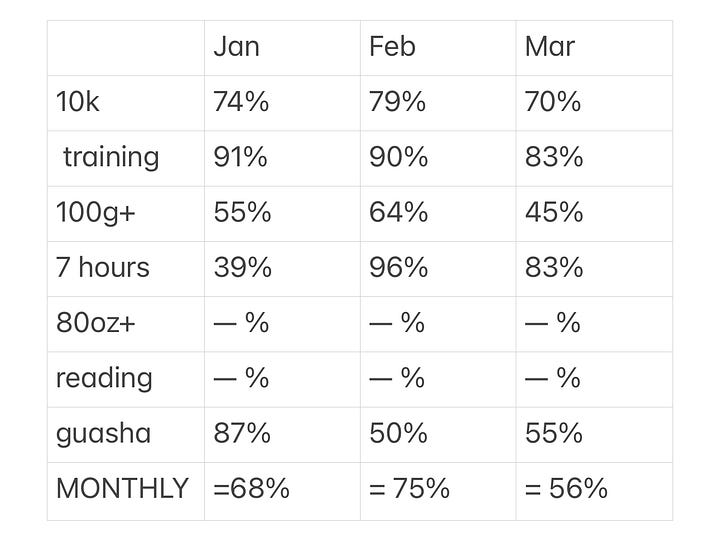
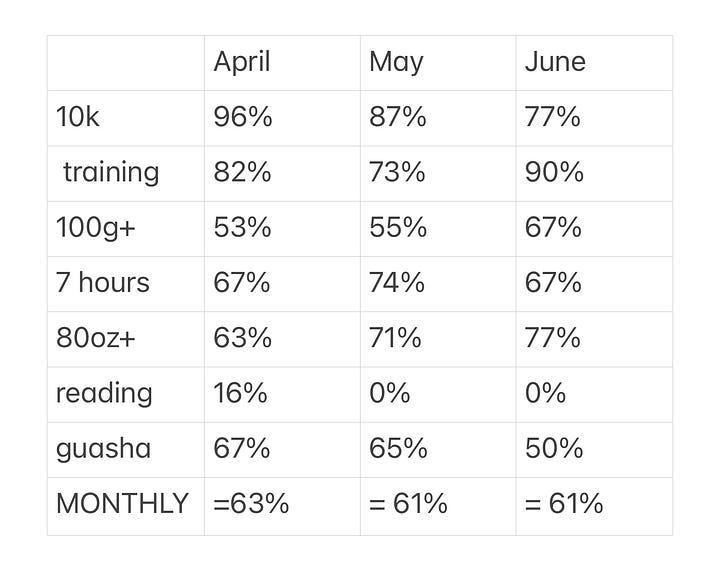
The monthly review showed June was about the same as May for performance/adherence but looking at each month side by side, I can see that Q2’s months were more consistent than Q1.
In order to compare each quarter quantitatively, I will look at my weekly grades instead of each habit’s grade from above. I only track 6 of these habits on Q’s Weekly Review (excludes reading) so those are my primary measurements of interest for behavior scoring. [plus the lack of reading is sure to tank my grades + it’s a new habit]


Summing each quarter to find the weekly average score tells me how well I adhere to my weekly goals on average. The average weekly score was 67.3% for Q1 and 73.2% for Q2. Comparatively, I did better week to week in Q2 for meeting my habit goals than Q1.
The monthly review showed June was about the same as May for performance but for the quarters Q2 seemed like quite an improvement. Let’s zoom out even further and evaluate the full 6 months of 2025 to see which pattern holds true.
6 month habit analysis:
Below is a simple graph showing my habit adherence for the first half of the year. The visual will help you better understand trends and areas where I need to improve. Feel free to create your own habit tracking graph to visualize your progress too! (links at the end)
The green trend line indicates that my habit behavior has been improving and is on an upward trend as of the mid-year point.
When looking back at the habits individually, it’s easy to see the trends and overall average behavior for each one.
Mid-Year Habit Averages:
Best Average Score: Strength training
Mid Average Score: 10k steps + Gua sha
Worst Average Score: water, sleep, protein
This means my areas of improvement for the remainder of the year will be to bring the water, sleep, and protein goals up to the level of the others.
Looking at the averages gives me a snapshot of my behavior this first half of the year but looking at the trends gives me a clearer idea of how my behavior has changed over time.
Mid-Year Habit Trends:






The 10k steps, 100g+ protein, 7 hours sleep, and 80 oz water goal all have upward trend lines, indicating that I have been doing better with each habit as the year progresses. The strength training trend line looks nearly straight, if not a little downward, indicating a consistent adherence to my gym routine. The only downward trend line so far is for the lymphatic drainage routine, meaning this habit has been slowly falling off.
Looking at just the averages told me where the areas of improvement are but now looking at the trends I can see which I have already starting working on.
My worst average grades (water, sleep, + protein) all have upward trend lines, meaning I am already working to bring those averages up. My mid-average grades being my steps and gua sha and each having a positive and negative trend line, respectively, tells me that my lymphatic drainage habit is one to play close attention to. My best average being my most consistent trend line also makes sense to me! Me and the gym are definitely besties by now, though there is still room for improvement.
The results speak for themselves, but now it’s time to reassess the process. While the results show areas of strength, they also highlight where my lifestyle system can be optimized. For instance, my water intake and reading habits are lagging behind, signaling that I need to double down on those areas to balance the system out.
What adjustments can I make to ensure my system is primed for even better outcomes in Q3? This is where the rubber meets the road as we refine the process for the next leg of the journey.
✨✨✨✨✨✨✨✨✨✨✨✨✨✨✨✨✨✨✨✨✨✨✨✨✨✨✨✨✨✨✨✨
5 process

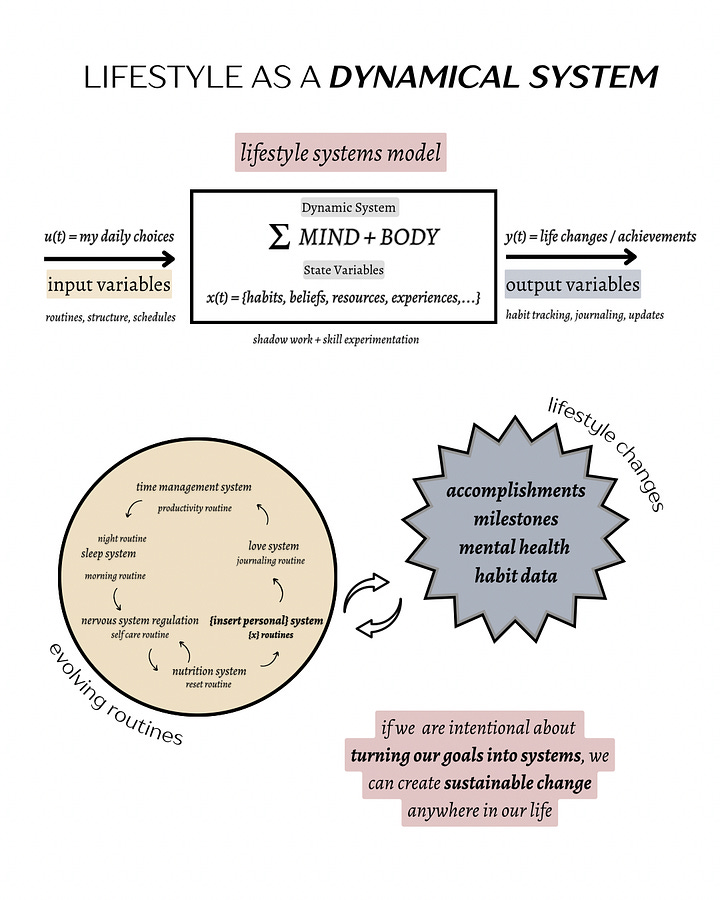
Now that we've reviewed the results, it's time to zoom in on the process — the engine behind the lifestyle system. A process is more than just a set of tasks; it’s the daily habits, the routines, and the mental shifts that drive sustained growth. This is where we ask: What’s working? What isn’t? And most importantly: What do I need to change to keep moving forward?
In this section, I’ll take a closer look at how my lifestyle system is functioning and where I see room for improvement as we move into Q3. We’ll be reviewing the routines that need to evolve, the non-negotiable actions that make the biggest impact, and the documentation that keeps everything in check. The goal is simple: optimize the process to create even better results.
What’s working:
My strength training consistency is strong, which supports both my health and productivity goals.
My weekly review routines are helping me stay on top of my priorities and ensure I’m making progress.
What isn’t working:
Sleep habits are inconsistent, which impacts my productivity and health.
My reading habit needs attention. I haven’t made enough time for it, despite it being an important part of my personal development.
To keep moving forward, I need to:
Prioritize better sleep by setting a stricter bedtime routine.
Commit to reading for at least 15 minutes every day to ensure I'm nurturing that intellectual growth.
My Q3 Plan:
As we head into Q3, I’m ready to implement the lessons from my midyear reset. Here’s how I plan to adjust my system and move closer to my goals in the coming months.
Updated Routines: I’ll be adding new habits to my system to fill in the gaps from Q2, especially around sleep and reading.
idea: habit stacking daily steps with reading
Daily Non-Negotiables: These will include my strength training, water intake, and lymphatic drainage routine for consistency.
Documentation: I’ll continue tracking my habits with my templates and review my progress weekly and monthly to stay accountable.
Key Takeaways for Your Own Midyear Reset:
Review Your System: Reflect on where you stand with your goals and systems. Take stock of what’s working well and what needs improvement. Ask yourself: Are my daily actions aligned with my goals? Be honest and intentional in assessing both.
Refine Your Routines: Don’t be afraid to adjust your daily and weekly routines to ensure they’re helping you, not hindering you. You don’t have to overhaul everything, but make small tweaks where it matters most.
Double Down on Non-Negotiables: Identify those few habits and actions that are truly essential to your success. Make these non-negotiable and incorporate them into your routine without fail. What are the daily actions that move the needle for you?
Document Your Journey: Keep track of your progress, reflect on setbacks, and use your feedback loops to inform future decisions. Use the tools and templates provided to track your progress, reflect on your results, and plan for the future. Accountability starts with documentation.
As we dive into Q3, I'm refining my own process with new routines, updated goals, and the same commitment to daily intention. I’m excited to see how these changes will play out, and I’m even more excited to share the tools that helped me along the way.
To make your own process updates easier, I’ve included downloadable templates that you can customize to fit your system. These tools are designed to help you track your progress, reflect on what’s working (and what’s not), and stay accountable as you move forward: (click to access link)
Weekly Report Card Template — A simple way to assess how you’re doing each week.
Quarter Review Template — A tool to reflect on the past quarter and analyze your successes and areas for growth
Quarter Reset Booklet — A step-by-step guide to help you update and reset your system for the next quarter.
Download these tools and get started on your own midyear reset! I’d love to hear how your midyear reset is going and what strategies you’re using to recalibrate. Drop a comment below or tag me on social to share your reset plan!
✨✨✨✨✨✨✨✨✨✨✨✨✨✨✨✨✨✨✨✨✨✨✨✨✨✨✨✨✨✨✨✨
This midyear reset isn’t just about changing what’s not working — it’s about reinforcing what is. By actively tuning our process, we can set ourselves up for an even stronger second half of the year. Let’s finish this year strong, with a system that keeps us aligned and on track for our goals.
SOURCES:
https://www.tutorialspoint.com/system_analysis_and_design/system_analysis_and_design_quick_guide.htm






